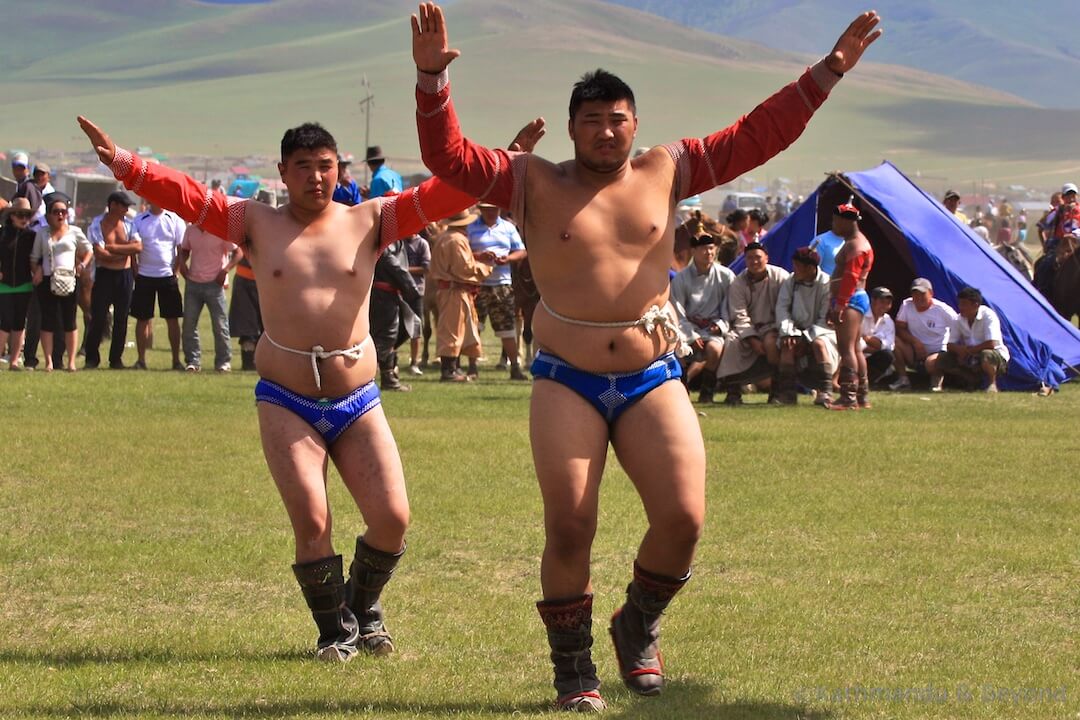Welcome to the first post in a brand new series – Friday Flashback.
The focus of Friday Flashback is a photograph from our past travels – it may be one taken over the past few months, possibly from a year or so ago or it may be a photo from deep in our travel archives. The photo will contain an image that evokes memories for us, and we will recall the story behind the picture.
First up is this photograph of the “eagle dance” wrestlers of Mongolia. Exactly this time four years ago (I can’t believe it really was four years ago!) we were in Mongolia for the world-famous Nadaam Festival and we were lucky enough not only to experience both the opening ceremony and the games in the capital, Ulaan Baatar, but also to witness the games, on a smaller and more personal scale, in the rural town of Kharkhorin.
The Mongolian word nadaam means game or competition and although the games have many elements, the most important competitions are those known as the “three manly skills”, namely horse racing, archery, and wrestling.
Wrestling has been a key part of Mongolian culture for many centuries with some historians claiming it first originated seven thousand years ago. Apparently, wrestling was the training method used by Genghis Khan to keep his army at peak physical strength, ready for combat. The wrestlers in this photograph are performing the traditional eagle dance – a ritual that is carried out both before and after the match.
 Wrestlers preparing to compete in one of the games’ most popular sports at Naadam Festival in the town of Kharkhorin. Although wrestling is considered by Mongolians as a manly sport, the traditional dress of very snug-fitting briefs, ankle boots and a kind of silk shrug cardigan is hardly macho!
Wrestlers preparing to compete in one of the games’ most popular sports at Naadam Festival in the town of Kharkhorin. Although wrestling is considered by Mongolians as a manly sport, the traditional dress of very snug-fitting briefs, ankle boots and a kind of silk shrug cardigan is hardly macho!
Known in Mongolian as devekh, the dance is said to be based on the flight of the mythical bird, Garuda, and has its origins in shamanistic rituals. The dance symbolises bravery, strength, grace, and invincibility and shows off the wrestlers’ physical prowess. The ritual movements also serve as a warm-up exercise before the fight. During the dance, each wrestler’s accomplishments and heroic deeds are proclaimed to the audience by his trainer. Accomplishments could include his title which is awarded according to how many rounds a wrestler has previously won – five rounds earn the title of falcon, seven rounds is an elephant and the accolade for winning a whole tournament is lion. Titles can only be earned during a Nadaam Festival placing great importance on success during these games.
The winner gets to perform the eagle dance again after the fight and it’s traditional for the loser of the bout to remove his jacket and walk under the winner’s arms, which are spread out like a conquering bird of prey.
Nadaam Festival takes place in Ulaan Baatar every year from the 11th to the 13th of July with smaller, local versions in towns in the countryside following once the main event has finished.
The original posts documenting our travels in Mongolia and all our photographs of Mongolia including more of Nadaam Festival can be found via the following links:

Yeah, I was kind of thinking the same thing looking at those briefs. Wouldn’t want to meet those guys in the shower.
Frank (bbqboy)